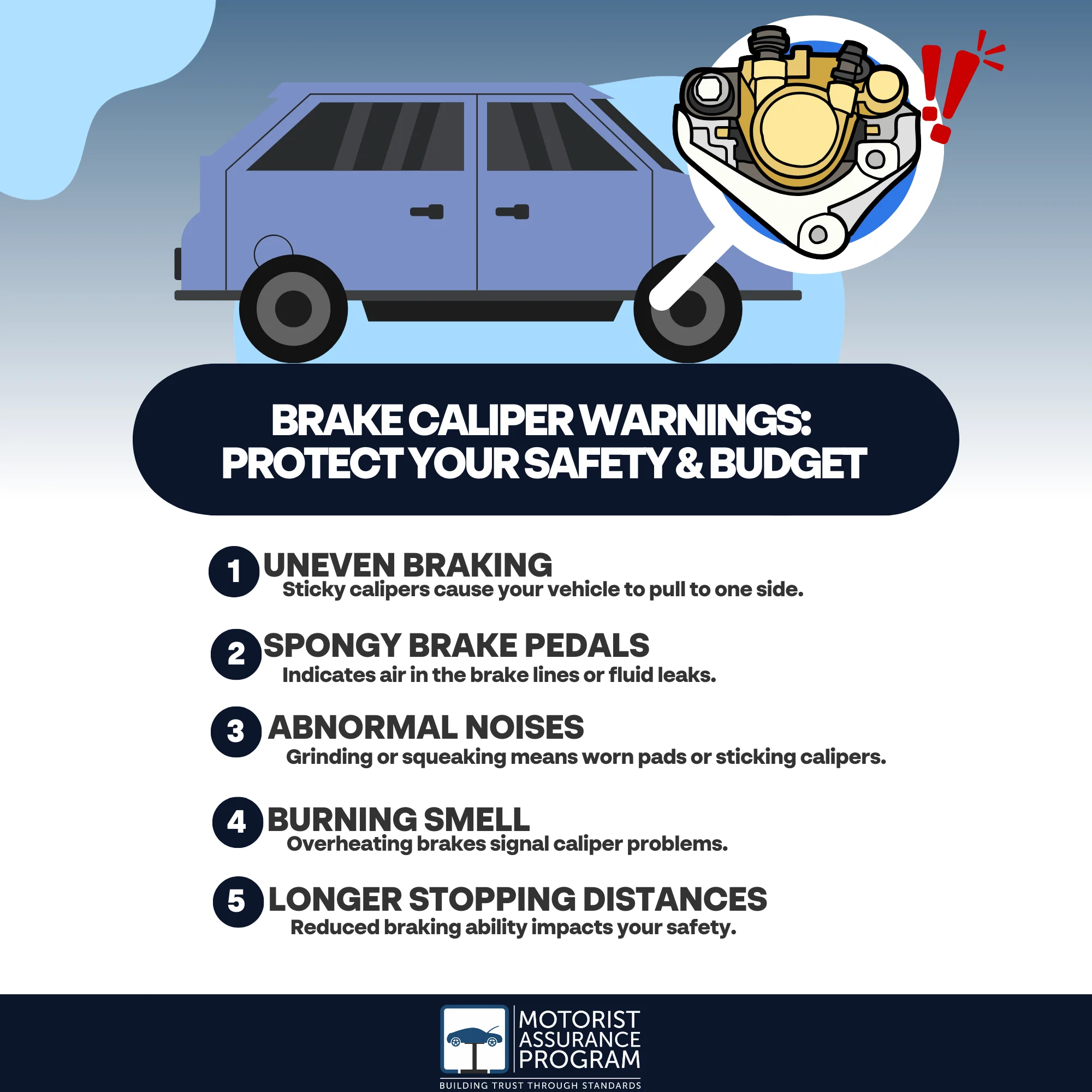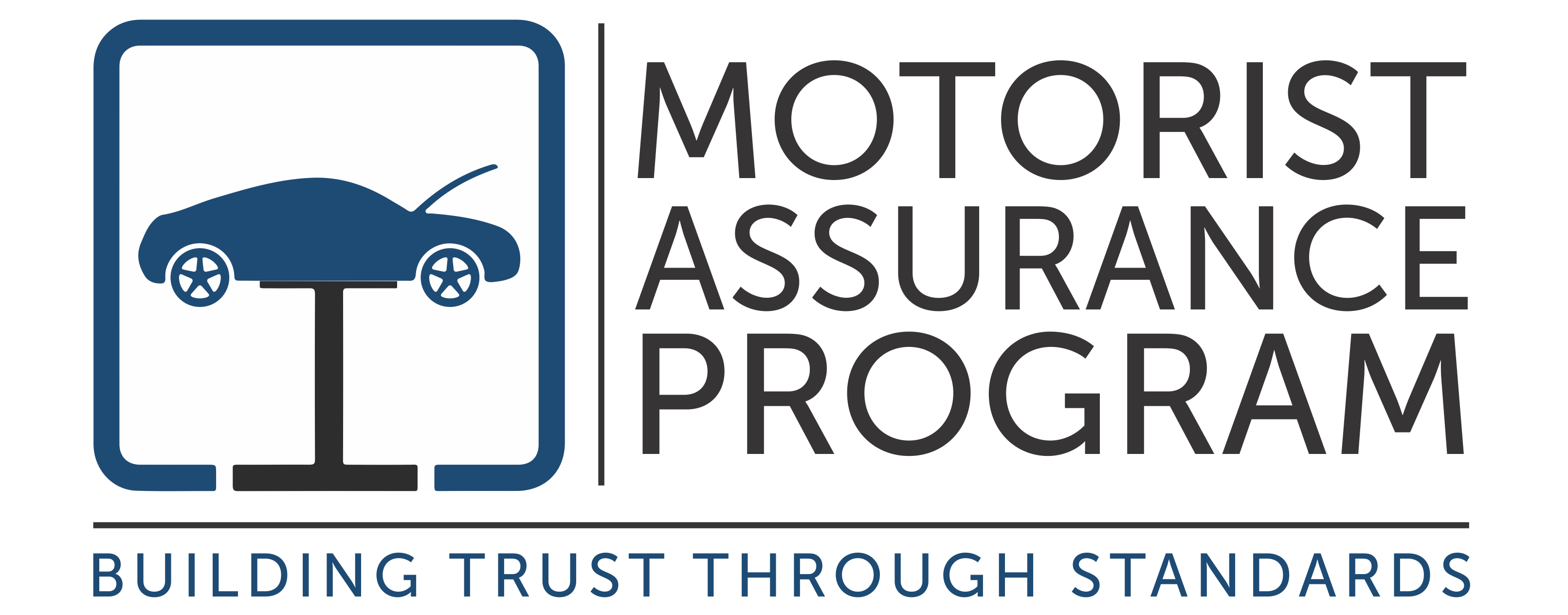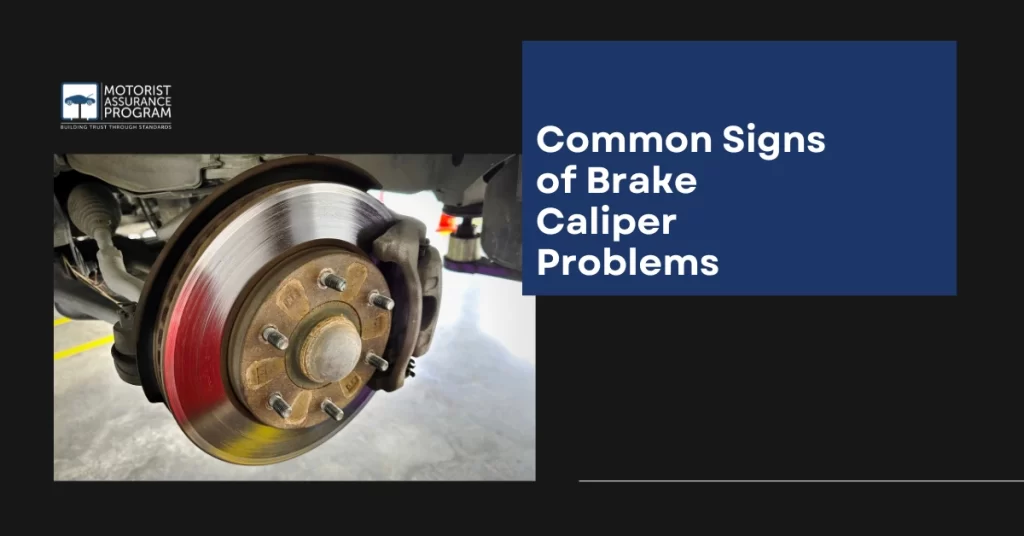Common signs of brake caliper problems include your vehicle pulling to one side, which indicates uneven braking force from a sticky caliper. You might also notice a spongy or soft brake pedal, suggesting air in the brake lines. Grinding or squeaking noises can point to worn brake pads or insufficient lubrication. If you feel vibrations in the brake pedal, that’s a red flag for uneven wear. Finally, a burning smell or excessive heat from the wheels may signal overheating. These symptoms should prompt immediate inspection; understanding them could save you from costly repairs later.

Key Takeaways
- Vehicle Pulling to One Side: Indicates uneven braking due to a sticking caliper, causing the vehicle to veer left or right.
- Spongy or Soft Brake Pedal: A soft pedal feel may suggest air in brake lines or issues with calipers affecting pressure.
- Abnormal Noises: Grinding, squeaking, or clunking sounds can signal worn pads, improper lubrication, or malfunctioning calipers.
- Vibration or Pulsation in the Brake Pedal: Uneven wear or malfunction of brake components may cause noticeable pedal vibrations.
- Burning Smell or Excessive Heat: Overheating brakes can indicate caliper issues, often resulting in a burning odor and reduced performance.
Pulling to one side
Experiencing your vehicle pulling to one side while driving can be frustrating and often indicates an underlying brake caliper issue. When the brake caliper sticks, it can cause uneven braking force on your wheels. This situation leads to the vehicle veering left or right, depending on which caliper is affected.
Brake caliper problems typically arise from dirt, rust, or corrosion, which prevent the caliper piston from retracting properly. For example, if your right front caliper is sticking, you’ll notice your car pulling to the left when you brake. This not only affects your driving experience but also compromises safety and can lead to premature tire wear.
To diagnose this issue, visually inspect your brake components for signs of wear or damage. A temperature difference between the wheels can also signal a sticking caliper; the affected wheel may feel hotter than the others after driving.
Resolving brake caliper sticking usually involves cleaning or replacing the caliper and ensuring the braking system is well-maintained. Regular brake inspections can help you catch these problems early, ensuring safer and smoother driving.
Fluid leaks
Fluid leaks from brake calipers can lead to significant safety hazards and performance issues. When you notice any liquid pooling under your vehicle, it’s crucial to identify whether it’s brake fluid. This leak often indicates brake caliper problems symptoms, such as worn seals or cracks in the caliper housing.
If you spot a leak, don’t ignore it. Brake fluid is vital for effective brake operation, and losing it can result in brake caliper failure symptoms, including reduced braking efficiency and increased stopping distances. You might also experience a noticeable drop in the brake fluid reservoir level, which you can check regularly.
In some instances, leaking brake fluid can lead to corrosion of the brake components, further exacerbating the problem. If you experience any of these issues, it’s best to consult a professional mechanic immediately. They can diagnose the leak and determine if you need a caliper replacement or a simple seal repair.
Addressing brake fluid leaks swiftly can save you from more extensive repairs and, more importantly, guarantee your safety on the road. Don’t let fluid leaks compromise your vehicle’s braking system.
Spongy or soft brake pedal
A spongy or soft brake pedal can indicate underlying issues with your brake calipers or the brake system as a whole. When you press the pedal, you should feel immediate resistance; if it feels soft or sinks to the floor, there could be a problem. This symptom often arises from air in the brake lines, which can occur from a brake fluid leak or improper bleeding during maintenance.
Brake caliper sticking symptoms can also contribute to this issue. If a caliper isn’t releasing properly, it can cause uneven pressure in the brake system, leading to that spongy feel. You might notice reduced responsiveness while braking or a pedal that feels less firm than usual.
If you’re experiencing this symptom, it’s crucial to inspect your brake system promptly. Start by checking for visible leaks or worn components. If you find nothing obvious, the issue may lie deeper within the brake caliper or master cylinder. Ignoring a spongy or soft brake pedal can lead to more extensive damage and compromised safety, so don’t delay in getting it assessed by a professional.
Reduced braking ability
When your vehicle exhibits reduced braking ability, it often signals an issue with the brake calipers or other components of the braking system. This can manifest as longer stopping distances or a noticeable lack of responsiveness when you apply the brakes. You may find that pressing the pedal feels less effective, requiring more force to achieve the desired deceleration.
To determine how to tell if the brake caliper is bad, pay attention to any unusual noises, like grinding or squeaking, that could indicate a malfunction. Remember to inspect your brake fluid level; a low level might suggest a leak in the calipers. If you notice any fluid pooling near the wheels, that’s another red flag.
Another indication of brake caliper problems is if the vehicle pulls to one side during braking. This could mean that one caliper isn’t pressing onto the brake pad properly, affecting braking efficiency. If you experience any of these symptoms, it’s necessary to address the issue quickly. Ignoring reduced braking ability can lead to severe safety risks and potentially costly repairs down the road. Always consult a professional mechanic for a thorough inspection and diagnosis.
Uneven brake pad wear
Uneven brake pad wear often accompanies reduced braking ability and can be a direct result of faulty brake calipers. When your brake calipers encounter issues, such as sticking or seizing, they can apply uneven pressure to the brake pads. This leads to one side of the pad wearing down more quickly than the other, which isn’t just a minor nuisance—it can compromise your vehicle’s overall braking performance.
You might notice signs of brake caliper sticking, including a noticeable pull to one side when braking or unusual noises like squeaking or grinding. If left unchecked, this uneven wear can lead to costly repairs, including rotor damage.
To diagnose uneven wear, inspect your brake pads regularly. Look for significant differences in thickness or uneven surfaces. If you spot these irregularities, it’s a clear indicator that your brake calipers may need attention.
Dragging sensation
Experiencing a dragging sensation while driving can signal a serious problem with your brake calipers. This sensation often indicates that the brake calipers are stuck, preventing the brake pads from fully releasing. When this happens, your vehicle may feel as though it’s constantly braking, which can lead to overheating and uneven wear on components.
Here are some common causes of brake caliper problems:
- Corrosion: Rust can build up on the caliper, causing it to seize.
- Dirty or damaged pins: If the caliper guide pins are contaminated or damaged, they may not allow the caliper to move freely.
- Old brake fluid: Moisture can lead to hydraulic issues, making it difficult for the caliper to retract.
- Faulty caliper piston: A malfunctioning piston can lead to inconsistent pressure, causing the caliper to stick.
If you notice this dragging sensation, it’s imperative to have your brake system inspected. Ignoring the issue can lead to more severe problems, such as brake failure or costly repairs down the line. Always prioritize your vehicle’s braking performance for your safety.
Abnormal noise
If you hear abnormal noises coming from your brakes, it could indicate a malfunctioning brake caliper. These noises often manifest as grinding, squeaking, or clunking sounds. Grinding typically suggests that the brake pads are worn down and metal is making contact with the rotor, which can lead to severe damage if not addressed. Squeaking noises might indicate that the brake pads are not properly lubricated or that the caliper is sticking, creating excessive friction. Clunking sounds can signal that your caliper is loose or that internal components are failing.
When diagnosing brake caliper problems, start by inspecting the brake components for wear and tear. Listen closely while driving at low speeds, as this can help you pinpoint the source of the noise. Pay attention to whether the sound occurs during braking or while coasting.
If you notice any abnormal brake caliper problems noise, it’s vital to address it immediately. Ignoring these signs can lead to further brake system failure or even a potential accident. Regular maintenance and prompt attention to unusual sounds can keep your braking system functioning safely and effectively.
Frequently Asked Questions
How Often Should I Inspect My Brake Calipers?
You should inspect your brake calipers at least every 12,000 miles or during routine maintenance. If you notice any unusual noises or vibrations, check them sooner to guarantee peak braking performance and safety.
Can I Drive With a Faulty Brake Caliper?
You shouldn’t drive with a faulty brake caliper. It compromises braking efficiency, increases stopping distances, and could lead to complete brake failure. Prioritize safety—get it inspected and repaired immediately.
What Causes Brake Caliper Problems?
Brake caliper problems often stem from issues like corrosion, fluid leaks, or wear and tear on the piston seals. Heat buildup during braking can also cause failure, leading to uneven braking performance and safety risks.
Are Brake Caliper Issues Covered Under Warranty?
Generally, brake caliper issues are covered if they arise from defects. Check your warranty details; it often specifies conditions, mileage limits, and maintenance requirements that affect coverage.
How Much Does It Cost to Replace a Brake Caliper?
Replacing a brake caliper typically costs between $300 and $800, depending on your vehicle’s make and model. Labor and parts can vary, so it’s wise to get quotes from multiple mechanics for the best deal.
Conclusion
If you notice any of these signs, don’t ignore them; it’s time to take action before you find yourself in a real pickle. Addressing brake caliper issues early can save you from costly repairs and guarantee your safety on the road. Regular inspections and maintenance can help catch these problems before they escalate. Remember, your brakes are your first line of defense, so keep them in top shape for a smoother, safer ride.


